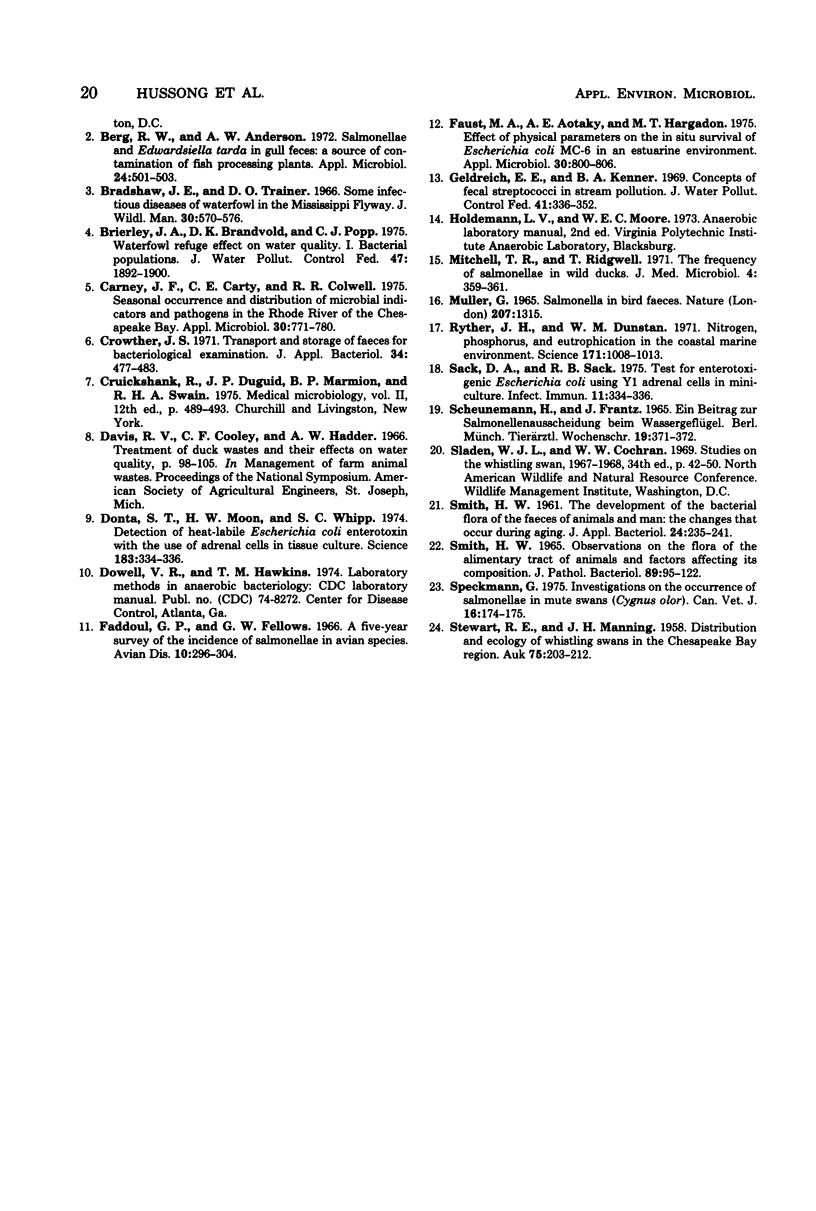Abstract
Quantitative and qualitative analyses of the intestinal bacterial flora of Canada geese and whistling swans were carried out with the finding that wild birds harbor significantly more fecal coliforms than fecal streptococci. The reverse was typical of captive and fasting birds. Neither Salmonella spp. nor Shigella spp. were isolated from 44 migratory waterfowl that were wintering in the Chesapeake Bay region. Enteropathogenic Escherichia coli were detected in seven birds. Geese eliminated 10(7) and swans 10(9) fecal coliforms per day. Results of in situ studies showed that large flocks of waterfowl can cause elevated fecal coliform densities in the water column. From the data obtained in this study, it is possible to predict the microbial impact of migratory waterfowl upon aquatic roosting sites.
Full text
PDF






Selected References
These references are in PubMed. This may not be the complete list of references from this article.
- Berg R. W., Anderson A. W. Salmonellae and Edwardsiella tarda in gull feces: a source of contamination in fish processing plants. Appl Microbiol. 1972 Sep;24(3):501–503. doi: 10.1128/am.24.3.501-503.1972. [DOI] [PMC free article] [PubMed] [Google Scholar]
- Brierley J. A., Brandvold D. K., Popp C. J. Waterfowl refuse effect on water quality: I. Bacterial populations. J Water Pollut Control Fed. 1975 Jul;47(7):1892–1900. [PubMed] [Google Scholar]
- Carney J. F., Carty C. E., Colwell R. R. Seasonal occurrence and distribution of microbial indicators and pathogens in the Rhode River of Chesapeake Bay. Appl Microbiol. 1975 Nov;30(5):771–780. doi: 10.1128/am.30.5.771-780.1975. [DOI] [PMC free article] [PubMed] [Google Scholar]
- Crowther J. S. Transport and storage of faeces for bacteriological examination. J Appl Bacteriol. 1971 Jun;34(2):477–483. doi: 10.1111/j.1365-2672.1971.tb02307.x. [DOI] [PubMed] [Google Scholar]
- Donta S. T., Moon H. W., Whipp S. C. Detection of heat-labile Escherichia coli enterotoxin with the use of adrenal cells in tissue culture. Science. 1974 Jan 25;183(4122):334–336. doi: 10.1126/science.183.4122.334. [DOI] [PubMed] [Google Scholar]
- Faust M. A., Aotaky A. E., Hargadon M. T. Effect of physical parameters on the in situ survival of Escherichia coli MC-6 in an estuarine environment. Appl Microbiol. 1975 Nov;30(5):800–806. doi: 10.1128/am.30.5.800-806.1975. [DOI] [PMC free article] [PubMed] [Google Scholar]
- Mitchell T. R., Ridgwell T. The frequency of salmonellae in wild ducks. J Med Microbiol. 1971 Aug;4(3):359–361. doi: 10.1099/00222615-4-3-359. [DOI] [PubMed] [Google Scholar]
- Müller G. Salmonella in bird faeces. Nature. 1965 Sep 18;207(5003):1315–1315. doi: 10.1038/2071315a0. [DOI] [PubMed] [Google Scholar]
- Ryther J. H., Dunstan W. M. Nitrogen, phosphorus, and eutrophication in the coastal marine environment. Science. 1971 Mar 12;171(3975):1008–1013. doi: 10.1126/science.171.3975.1008. [DOI] [PubMed] [Google Scholar]
- SMITH H. W. OBSERVATIONS ON THE FLORA OF THE ALIMENTARY TRACT OF ANIMALS AND FACTORS AFFECTING ITS COMPOSITION. J Pathol Bacteriol. 1965 Jan;89:95–122. [PubMed] [Google Scholar]
- Sack D. A., Sack R. B. Test for enterotoxigenic Escherichia coli using Y-1 adrenal cells in miniculture. Infect Immun. 1975 Feb;11(2):334–336. doi: 10.1128/iai.11.2.334-336.1975. [DOI] [PMC free article] [PubMed] [Google Scholar]
- Speckmann G. Investigation on the occurrence of salmonellae in mute swans (Cygnus olor). Can Vet J. 1975 Jun;16(6):174–175. [PMC free article] [PubMed] [Google Scholar]


